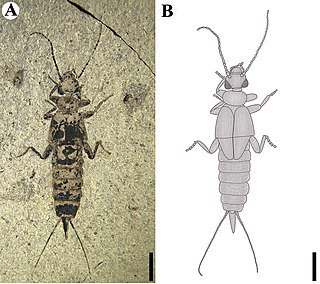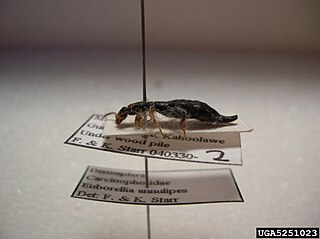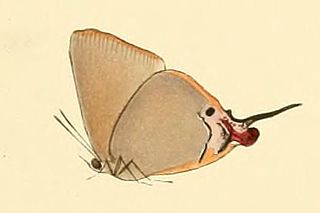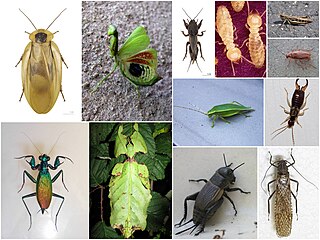Related Research Articles

Earwigs make up the insect order Dermaptera. With about 2,000 species in 12 families, they are one of the smaller insect orders. Earwigs have characteristic cerci, a pair of forcep-like pincers on their abdomen, and membranous wings folded underneath short, rarely used forewings, hence the scientific order name, "skin wings". Some groups are tiny parasites on mammals and lack the typical pincers. Earwigs are found on all continents except Antarctica.

Forficula auricularia is a species complex comprising the common earwig or European earwig, an omnivorous insect in the family Forficulidae. The European earwig survives in a variety of environments and is a common household insect in North America. The name earwig comes from the appearance of the hindwings, which are unique and distinctive among insects, and resemble a human ear when unfolded; the species name of the common earwig, auricularia, is a specific reference to this feature. They are considered a household pest because of their tendency to invade crevices in homes and consume pantry foods, and may act either as a pest or as a beneficial species depending on the circumstances.
The mesothorax is the middle of the three segments of the thorax of hexapods, and bears the second pair of legs. Its principal sclerites are the mesonotum (dorsal), the mesosternum (ventral), and the mesopleuron (lateral) on each side. The mesothorax is the segment that bears the forewings in all winged insects, though sometimes these may be reduced or modified, as in beetles (Coleoptera) or Dermaptera, in which they are sclerotized to form the elytra, and the Strepsiptera, in which they are reduced to form halteres that attach to the mesonotum. All adult insects possess legs on the mesothorax. In some groups of insects, the mesonotum is hypertrophied, such as in Diptera, Hymenoptera, and Lepidoptera), in which the anterior portion of the mesonotum forms most of the dorsal surface of the thorax. In these orders, there is also typically a small sclerite attached to the mesonotum that covers the wing base, called the tegula. In one group of insects, the Hemiptera, the dorsal surface of the thorax is typically formed primarily of the prothorax, but also in part by the enlarged posterior portion of the mesonotum, called the scutellum; in the Coleoptera, the scutellum may or may not be visible, usually as a small triangular plate between the elytral bases, thus similar in position to the Hemipteran scutellum. In Diptera and Hymenoptera the mesothoracic scutellum is also distinct, but much smaller than the mesoscutum.

Forficulidae is a family of earwigs in the order Dermaptera. There are more than 70 genera and 490 described species in Forficulidae.

Archidermaptera is an extinct suborder of earwigs in the order Dermaptera. It is one of two extinct suborders of earwigs, and contains two families known only from Late Triassic to Early Cretaceous fossils. The suborder is classified on the basis of general similarities. The Archidermaptera share with modern earwigs tegmenized forewings, though they lack the distinctive forceps-like cerci of modern earwigs, have external ovipositors, and possess ocelli. The grouping has been suggested to be paraphyletic.

Arixeniidae is a family of earwigs in the suborder Neodermaptera. Arixeniidae was formerly considered a suborder, Arixeniina, but was reduced in rank to family and included in the new suborder Neodermaptera.

Anisolabididae is a family of earwigs, in the suborder Forficulina and the order Dermaptera.
Dendroiketes is a genus of earwigs, in the family Apachyidae. It is one of only two genera in Apachyidae.

Apachyus is a genus of earwigs, in the family Apachyidae. It is one of only two genera in Apachyidae.

Diplatyidae is a family of earwigs in the suborder Neodermaptera. It contains three subfamilies, and four genera incertae sedis, one modern and three extinct known from fossils.

Labiduridae, whose members are known commonly as striped earwigs, is a relatively large family of earwigs in the suborder Forficulina.
Euborellia plebeja is a species of earwig in the family Anisolabididae. Like other members of the Anisolabididae family, this species has an elongated virga, a sclerotized tube that is part of the male genitalia.

Protelytroptera is an extinct order of insects thought to be a stem group from which the modern Dermaptera evolved. These insects, which resemble modern Blattodea, or cockroaches, are known from the Permian of North America, Europe and Australia, from the fossils of their shell-like forewings and the large, unequal anal fan. None of their fossils are known from the Triassic, when the morphological changes from Protelytroptera to Dermaptera presumably took place.

Myrina dermaptera, the lesser fig-tree blue or scarce fig-tree blue, is a butterfly of the family Lycaenidae. It is found in Sub-Saharan Africa, southern Arabia and northern Oman.

Labia minor, the lesser earwig or small earwig, is a species of earwig. It is widespread globally in temperate climates, preferring warm locations such as compost heaps in parts of its range. It is 4–7 mm long, including the pincer, and chocolate brown in color.

Spongiphoridae is a family of little earwigs in the suborder Neodermaptera. There are more than 40 genera and 510 described species in Spongiphoridae.

The cohort Polyneoptera is one of the major groups of winged insects, comprising the Orthoptera and all other neopteran insects believed to be more closely related to Orthoptera than to any other insect orders. They were formerly grouped together with the Palaeoptera and Paraneoptera as the Hemimetabola or Exopterygota on the grounds that they have no metamorphosis, the wings gradually developing externally throughout the nymphal stages. Many members of the group have leathery forewings (tegmina) and hindwings with an enlarged anal field (vannus).

Neodermaptera, sometimes called Catadermaptera, is a suborder of earwigs in the order Dermaptera. There are more than 2,000 described species in Neodermaptera.

Walter Douglas Hincks was a British entomologist and museum curator. He was a world expert on the Dermaptera.
References
- ↑ See first external link for reference.
- ↑ Dermaptera Species File: Apachyidae